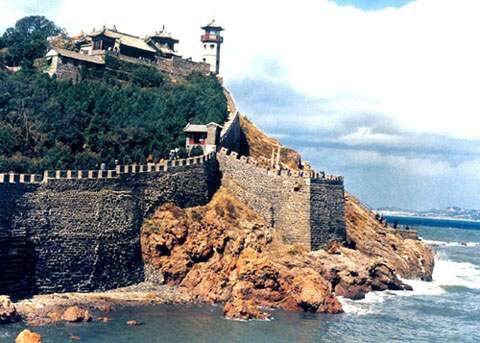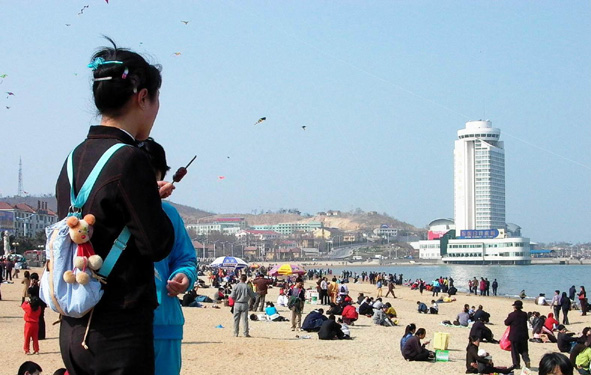|
Yantai located at the middle part of Shandong Peninsula, overlooks Liaodong Peninsula across the Bohai Sea and Huanghai Sea to its north. The city has total area of 13,000 square km, and the cultivated land of 467,000 hectares in which there are 300,000 hectares for framing, and 500,000 hectares grain sown area annually. The city has 909 km coastal line, with 600,000 hectares zone possible for developing. The city has 4 districts, 7 county-level cities and 1 county with the total population of 6.43 million, in which 4.45 million are peasants.
Yantai located at the middle latitude , enjoys the seasonal continental temperate climate with annual average temperature of 11.8ˇć, average rainfall about 700mm and more than 200 days forest-free days.

History
Yantai has a long history and it is called "Zhifu" in the ancient times. In B.C. 200 years, Chinese first emperor drew a bow to shoot the fish here, the left site is called "diao yu tai"(in Chinese, it means the place where you fish). In A.D.1398, in order to defense the enemies from the sea, the government of the Ming Dynasty built the beacon tower here, from which the city derived her name "Yantai"( in Chinese, it means the place where smoke is produced to give warning ). In 1861, Yantai became one of the first opening ports in the modern China.
Yantai is the birthplace of the famous Shandong cuisine and also boasts richness in marine products. Peanuts and various fruits are the major agricultural exports while wines and clocks are well known throughout the country.
Economy

In 2002, Yantai's GDP reaches US$ 111.5 billion; the primary, secondary and tertiary industries realize added value of US$ 13.603 billion, 57.45 billion and 40.447 billion respectively, which is the third among 17 cities in Shandong Province. The proportion of the three industies is 12.2 : 51.5 : 36.3. The tertiary industry keeps increasing and achieves the historical highest level. The number of individual and private business of the whole city is up to 13.560000 units and the tax revenue ( without individual income tax of interest ) reaches RMBŁ¤1.088 billion.
The social security system has initially formed, which includes endowment insurance, unemployment insurance, medical treatment insurance, industrial injury insurance and birth insurance. Altogether 554,000 enterprise employees have participated in endowment insurance; 120,000 enterprise retirees receive pension on time; the total ammount of insurance premium is RMBŁ¤1.64 billion, among which endowment insurance is RMBŁ¤1.05 billion, medical treatment insurance is RMBŁ¤473 million, unemployment insurance is RMBŁ¤100 million, birth insurance is RMBŁ¤14.263 million and industrial injury insurance is RMBŁ¤4.22 million.
The market price remains stable. Consumption price rises by 0.4% than the year of 2000 and drops by 0.6% than the same period of last year. Price index of industrial products is 98.8%.
Tourism
Yantai is located at the middle part of Shandong Peninsula, close to the Yellow Sea and Bohai Sea, crosses the sea against Liaodong Peninsula, Japan, South Korea and North Korea. Yantai is an ideal tourism city with beautiful landscape and pleasant climate. Interesting sceneries and fascinating coastal line attracts thousands of tourists from all over the world. Penglai Pavilion, the stone Tablet Inscriptions of the North Wei Dynasty on Mt. Yunfen, Changdao Island--the fairyland on the sea, Horse Raising Island, National Forest Parks, Natural Preservation Areas, Provincial Tourism and Vacation Resorts are perfect traveling spots. Moreover, Yantai is a famous "hometown of hot spring", which attracts over 100,000 tourists from over 30 countries and regions such as the U.S.A., Germany, Japan and Hongkong etc. Yantai is also famous for its "immortal, sea, mountain, island and ancient culture" and is listed as national excellent tourism city.
Science and Technology

Yantai takes the industrial development of high and new technology as the focus and implements the strategy of "Develop Yantai by Science and Education". Scientific progress has remarkable function on the economic and social development. In 2001, among the 191 scientific and technical achievements, 1 item obtained National Prize for Progress in Science and Technology and 60 items won Provincial Prize in Science and Technology. 1100 items were patented and 780 won patent authentication. There are 72 items listed in national-level scientific and technological development projects, including 4 items of key brainstorm plan of National "Ten 5--year" Plan, 2 items of National '863' Program; and 140 items of provincial scientific and technological development plans at all levels. With 13 newly--built enterprises, there are altogether 314 high and new enterprises within the whole city.
Hometown of Fruits
With the title of "Hometown of Fruits", Yantai has developed fruit industry. Yantai is abundant with apple, Laiyang Pear, Pear with long stem, grape, hawthorn, big cherry and Chinese chestnut etc. Yantai is a Key Fruit Export Base in north China and the biggest Red Fuji Apple Production Base, which has 186,700 hectares of top--grade apple orchard. The output of Yantai apple accounts for 9% of national output and the export amount accounts for 1/4 of the whole country. It is the biggest economic culture area of apple in China.
Natural Resources

With mountains guarding the back and seawater right in the front, Yantai abounds in gifts of natural resources and products. It has wide fishing grounds along the coast, more than 900 kilometers of coastline and over 600,000 hectares of shallow waters within 15 meters of isobaths. It abounds with prawns, sea cucumbers, abalones and scallops. It has a large quantities of mineral resources underground, of which over 30 kinds of exploitable ones have been verified to be available such as gold, copper, zinc, lead molybdenum, magnesium, coal, talc, marble, silver, iron and graphite, etc. The reserves of gold and talc take up 1/5 of the country's total respectively, while the reserves of marble rank the second of our country. Yantai is also a major production area of the famous Yantai apple and Shandong big peanut. What's more, Yantai big peanut, with longer growth period, bigger size, and higher content of protein and vitamin, are sold well at the international market, and more than 40 countries and regions is in great demand of it. Products such as tussah silk, Longkou vermicelli, giant cherry and laiyang pear, prawn, sea cucumber, abalone, etc. are well known all over the world.
Communication and transportation
Communication and transportation in Yantai are flourishing. As early as in the Spring & Autumn Period (770-467B.C.), Yantai was a very important port shipping lines between the Southeast Asia and the coastal provinces of Northeast China.
It was also one of the earliest trading ports of China opened to the outside world in modern time. There are 9 large/medium ports including four first-class ones (Yantai port, Longkou port, Penglai port and Laizhou port) opening to outside world and 23 berths, each with a handling capacity of over 10,000 tons. Total exchange capacity of the ports reaches 24.73 million tons.
Situated at Shandong Peninsula and in Zhifu Bay, Yantai is a key port of the state water transportation, an opening port along the coastline and an important hub of the great south-north highway between Sanya and Tongjiang, which is now under building by our country. The Yantai Port is 4.8 square kilometers and the coastline of Yantai port is 5,216 meters. It has 34 berths, among which, 15 berths in deepwater own a handling capacity of over 10,000 tons respectively and an exchange capacity of over 16 million tons (including container freight volume of 110,000 TEU).
The third phase of the construction of seven deepwater berths with expected annual handling capacity of 3,900,000 tons has started in August 1997. Four deepwater berths engaged in container freights were listed in the first phase of this construction. Passenger liners go to Tianjin and Dalian directly, and the liner named "Zi Yu Lan" comes and goes between Yantai and Pusan, Kunsan of Korea. Cargo ships offer freight services to more than 100 ports in scores of over 70 countries and regions throughout the world. Container freighters sail regularly between Yantai and Japan, the United States, Canada, Korea, Hong Kong and Singapore. Every year there are over 800 foreign ships enter Yantai Port for the first time. There will be 58 berths, including 43 deepwater berths, and the annual exchange capacity is expected to be more than 45 million tons in 2020. Railway between Yantai and Lancun joins up with the country's main line and contacts Yantai and many other cities like Beijing, Shanghai, Jinan, Qingdao, etc.
A complete highway network with high quality lines all counties, towns and most of the villages in the area. The highway length is 5,172 km in the area, and highway density is 36.5km/sq. km. The air transportation has achieved a great development. The construction of Laishan Airport has been completed and airlines have linked more than 20 citied, such as Beijing, Shanghai, Guangzhou, Shenyang, Harbin, Shenzhen, Xian, Xiamen, Wuhan, Shantou, Wenzhou, Dalian Chengdu, Haikou, etc. Meanwhile, liners to Hong Kong, Macao, Seoul of Korea has also been opened. Among which, there are three passenger liners from Yantai to Hong Kong and six ones from Yantai to Seoul. |